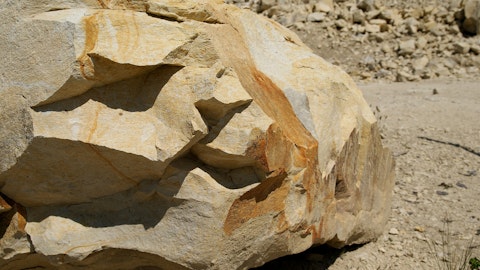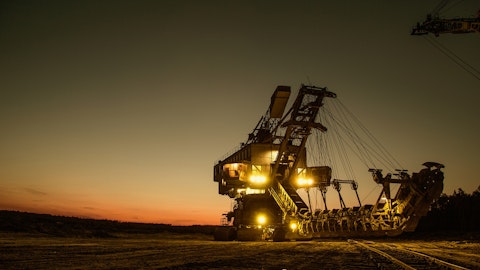Eduardo Bartolomeo: Okay. Hello, this is a very like, I think you as you understand this, I think it’s easier to explain to you, but let’s be very clear here, let’s separate Carajás Northern system with the S11D. S11D is all endogenous, it’s all in our hands, we need to take care that was built to compensate the loss that we were going to have on the depletion of the Northern Range. And we mentioned already, we are improving there. And that’s where the growth is coming. When you look at our guidance and our numbers for this year, there is no licensing at that edge on the Northern Range, we are planning with together to stabilize around the 100 million tons on Northern Range and . So how are we advancing with the legislation with the licensing, because, as you might understand, we had the last big license in Northern Range in 2014, if I’m not mistaken, and the last small one was in ’19.
And now we are pointing out to the body and three, that we already had the installation of the provisional license for that. But as it’s been early needs to have the feed to make iron solutions, we are working very thoughtfully but for the medium term, not for this year. This year, we did very well, by the way. We operated to the program in Carajás on the Northern Range where we hit the program, by the way. But it’s a program that is lower, we are aiming as I mentioned 100 million tons on both systems. So that is not an operational problem. They’re different from S11D, that I mentioned already. But we’re not sitting there and waiting. And not only the plus 20 that we already got the license, the plus standard is being commissioned. So growth from the northern system is going to come from S11D for sure.
That’s what is being designed. So we’re going to move from 80 something this year, we’re going to go up to 110, 120 that what we are investing by the way, and I think a good new deal — maybe we didn’t stress enough that we have licensed plus 20. So we are executing plus 20, onus S11D. There is no problem licensing there. So we are up and running with that project. But you’re right, we need to get back to the production on the northern region and . And it’s been early leading several initiatives that I think he can share some with you. Because we’re not sitting here waiting and letting our mind, I can’t do on 40, stay at .
Gustavo Pimenta: Eduardo. Let me just remind, the main projects, we already have the license for plus 10, plus 20 new crushers in north and south we have Capanema. So this is one site so we’ve been evolving in this site. In the northern ranges, as Eduardo mentioned, we have a combination of small licenses and big license that we need to metered long term. You may notice that we are not counting on that range with our volume. So we flat the production there to guarantee that we’re going to deliver that. So we have N3, N1 and N2 in sequence. And you mentioned a small piece sometimes is related to suppression or like cavities, as you mentioned. So we are working really close to the agencies. I believe that we have people in the front line.
I’m personally on the frontline to discuss this. We see good news coming with very technical analysis. We are bringing new studies, we’re bringing investment in the field like ITV, the Valley Technological Institute, that we are supporting a lot of this stuff. So we see in this new crew that is leading this in the government that we have very technical and grow in perspective about this. So we are confident, we need to work hard in this trend. But we are protecting our plan in the next three years to guarantee that’s going to deliver that.
Operator: Next question is from Thiago Lofiego, Bradesco.
Thiago Lofiego: Two questions. So the first one, sorry to insist on the cost front, Gustavo. But how confident are you guys on the guidance $2,0 $21 for the C1. So that would basically entail C1 costs below $20 every quarter from here to the end of the year, or significantly below $20 in the second half. I just want to try to understand how realistic this is just additional color on that would be great. Second question. For Spinelli. Spinelli, can you talk a bit about the reopening dynamics in China, we are seeing steel margins still depressed, steel prices actually falling at the margin. But at the same time, there’s some positive data out there, steel production is increasing. So what’s your take on supply and demand dynamics for iron ore becoming, let’s say a couple of quarters? And also what kind of a play is sentiment having on this whole, price formation story here for iron ore? Thank you.
Gustavo Pimenta: So Thiago, Gustavo, here, let me take the first one. So it’s going to be gradual. And most of the benefits we’ll see in the second half of the year, as we bring more volume, and as we bring better products into the mix, especially the products from Carajás, which has substantially lower C1. So you’re going to see the benefit from it, then there is about $0.5 to $1 of efficiency initiatives that we’ve been pursuing strategic sourcing, overhead efficiency, discussions that we’ve been having with some of our suppliers. So we’ve been laser focused, since last year on cost efficiency. So we are seeing benefits and we have that in our plan for the rest of the year. So you see a decrease — a gradual decrease, we are feeling good about it. And we believe that 20 to 21 is a reasonable number to be achieved, assuming that we bring the volume, especially from Carajás, online in the second half of the year.
Marcello Spinelli: Hey, Thiago. Spinelli here for your question. So we’ve been seeing the recovery in China. Definitely we have strong numbers. You mentioned that GDP FAI very resilient, infrastructure investment properties, we have good news also. So the bright side that we are in the stocking mall in China. So, we see the sales increasing also the accomplishment of construction also increase. You mentioned all the micro numbers, blast furnace going well, we just came from China. It’s a common sense that production will be flat this year. So the production is there. So what is concerning today, so, the first thing is related to property. It is a cycle. So we firstly we need to sell, finish the construction. So land sales and new starts are coming.
So that didn’t come yet. So that’s the main volatility that we see in our — even in our clients. They are in a wait and see mode. But everybody’s waiting that for only for the second half. So we are on track and we need to wait for that. I think price in steel, it’s another concern. But the good news is, if you see the export that you had in China, this quarter. That implies that we have a symmetry in the price, ex-China comparing to China. So there is a wind that can help China to improve the price in the steel market. And as a combination of all of this, we have a tepid or really tepid margins steel mill. So with all this, we have this wait and see behavior, we have old inventors are really low. So in our perspective in short-term, we can see a rebound, we have this next holiday that is coming out and they will need to replenish the supply chain.
In the second half, we need to wait and see what is going to happen to the property, I’m not saying that we see a growth in the property, but a smooth and flat demand. But just to conclude Thiago, I want to drag your attention and everybody that the supply demand balance is really tight. So that’s it, I think is a very important information to give to you. The demand ex-China is growing 1.5% to 2%, there’s a important demand. In the supply side, you have a growth but it’s not that important growth that is a balance in this in both growth. So we can see an addition of 5 million to 10 million tons in inventory that is very little today 130 million tons in China. So I’m talking about iron ore. So, we see a balance in the market for the iron ore and that can bring an upside risk for the price or at least the stability.
The name of the game of these years is stability, we are all the time try to bother that but production is very stable, the macro is coming and we see the supply very, very organized, very tight with the supply balance. Again, we are cautiously optimistic we do to wait and see the property market in the second half.
Operator: The next question is from Caio Ribeiro, Bank of America.
Caio Ribeiro: So my first question is on third-party ore purchases in the iron ore division, right? This quarter, you purchased almost a million tons no more than in first quarter 22. So I’m just wondering if you see room to increase third party ore purchases in 2023 for the full year versus last year. And if you can provide any indication on the volume of those purchases for the year. And then, my second question on your expanded net debt where you continue to follow a target of $10 billion to $20 billion I just wanted to understand if you would be willing to temporarily surpass like that upper range of the target, if you do encounter an attractive or smart M&A opportunity as you put it and if this opportunity does not unfold whether the focus will continue to be on cash returns via buybacks and dividends. Thank you.
Marcello Spinelli: Thank, Caio for questions. Third party is a trend. I don’t — we don’t see a huge growth of talking about 2 million or 3 million tons probably in this year. It is an ecosystem that we have mainly in Brazil, there are some — we say the smaller miners they’re big companies that we’ve been developing for many years. So we see a good thing here just to figure right we made a $20 ton in margins with this kind of business. So, it is — as we have capacity in our supply chain you have the market and if you can improve this product with some application like pelletizing plants for blending or even in the future, the briquette plants we made taken advantage of that. So that’s something that we want to strength and bring this partners more and more reliable and with more quality, sustainable way. So we want to foster that but for this year, we may expect some growth but smaller like numbers like 3 million tons.



